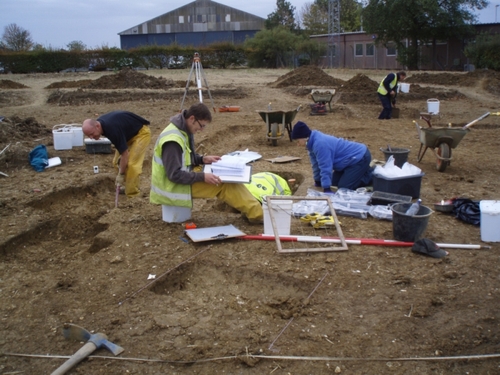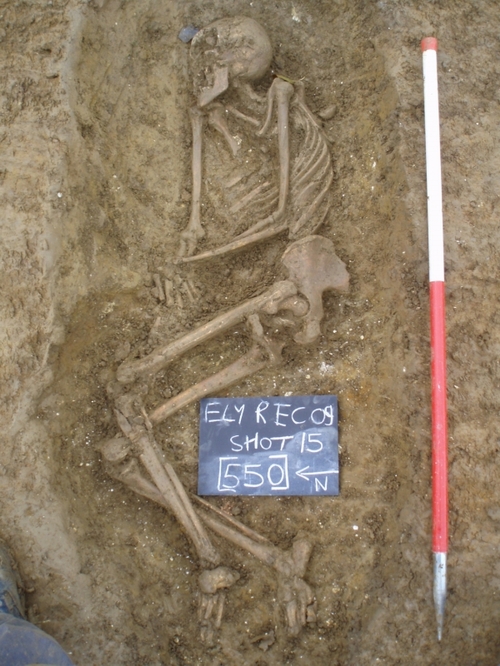Archaeological Investigations on Waste Disposal Site, Stirling Way, Nr Witchford

Although indicative of small scale earlier prehistoric activity at the site in this period, the assemblage is too small to inform on the precise nature of the occupation or the range of activities undertaken but hunting seems to have taken place.
There were two Beaker pits found within the site (c.2500-1500BC). Beaker pits are relatively scarce and so their recovery here is important – it is the first non funerary Beaker feature within a 5km radius. Elsewhere in Cambridgeshire there are only a few places where there are more substantial evidence for Beaker “domestic ” activity e.g at Fenstanton.
These pits may denote ‘stay over’ visits on the site. One of the pits may have had hearth material in its backfill as well as some hazel nut fragments, a little burnt bone and importantly c.40 small sherds from about four beaker vessels and three possible residual from a Late Bronze Age vessel. Two worked flint flake debitage pieces were also recovered denoting that natural flint pieces were being shaped to create flint tools on the site.
In the Late Iron Age (c.1st century BC) the first evidence for a permanent settlement was found and this was established on a plateau of a small knoll at c.15.9mOD. Evidence from other archaeological work in the Ely area have found that there were Iron Age and Roman settlements every few hundred metres to a kilometre or so and these were on land c.3m above sea level with marsh land below this height. Most of these settlements were individual farmsteads but a few may have been up to hamlet size.
Four phases of occupation on the site started c.1st century BC and continuing into the late c.2nd century AD. Later Roman occupation areas of the settlement were nearby to the northeast.
A few significant features included a large Late Iron Age boundary ditch, recut in the Early Roman period, more than 3m wide and up to 1.15m deep which meandered along the top contour of a ridge which ran roughly parallel and overlooked a strategic causeway (stream) route which flowed from Grunty Fen into West Fen. The role of this ditch may be linked to the name Witchford which according to Chris Evans of Cambridge University derives from ‘the Watch on the Ford’.
Three interesting burials were found within a small enclosure which lay in front of this ditch probably dating over a c.150 year period. It is uncertain whether this was a mortuary enclosure. Relatively few people were buried in the Late Iron Age and Roman period perhaps denoting these three people were from the middle or higher echlons of this rural farming community. In the Ely area, only one other settlement has found more burials despite several large scale excavations on several settlements.
The earliest was a middle 1st century AD cremation consisting of a shallow pit within which human cremated bones were placed within a grey ware vessel with an associated vessel next to it. These vessels would have been of use to the person in the afterlife. This is the first Late Iron Age type cremation yet found in the Ely area.
A few Late 1st century AD or 2nd century cremations have been found in Ely and Sutton. The other two burials were inhumations, probably 2nd century which had very uncommon grave goods placed within them. One mature woman was buried on top of two animal bone spindle-whorls (a fly-wheel which teases fibres out of a fleece). Spindle-whorls within Roman inhumation burials comprise only a tiny fraction of recorded burials in Britain.
A major survey of Roman burials published in 1991 found that individual spindle-whorls within inhumation burials were known from only 12 sites in England (this seems to be the first Roman burial with two spindle-whorls).
The other burial, placed in a very deep (0.59m) grave was a woman aged between 26-44 who had only tooth surviving, the rest had been lost naturally and she had five copper alloy rings on her left hand including three on a single finger (this might suggest that the corpse was dressed up in her finery for burial). The 1991 survey records there were 24 graves across England where there are only ring(s) worn and a further 10 where they were also within a mixture of grave goods.
Only one other burial can be paralleled with five rings on its fingers. Two pottery vessels, including a complete Nene Valley folded indented beaker were placed within the enclosing ditch around the burials with the beaker situated opposite her head. This vessel again may have use in the afterlife.
The excavation has made an important contribution to our understanding of prehistoric and Roman people in the Witchford area. A report of the findings will be finished soon.


Recent Comments